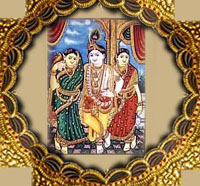 Tanjore painting is a classical art form that has been practiced by the people in Southern Tamil Nadu for the past two centuries. The art flourished in Tanjavur, pronounced Tanjore, the capital city of the Chola dynasty. Beauty is the chief characteristics of this painting. Tanjore painting is truly a reflection of the beautiful, rich and full bodied colours. The theme of this painting is religious and it mainly depicts Gods and Goddesses. The paintings of Tanjore today adorn the living rooms, drawing rooms, corporate office corridors, pooja rooms etc and are zealously guarded by those who have them.
Tanjore painting is a classical art form that has been practiced by the people in Southern Tamil Nadu for the past two centuries. The art flourished in Tanjavur, pronounced Tanjore, the capital city of the Chola dynasty. Beauty is the chief characteristics of this painting. Tanjore painting is truly a reflection of the beautiful, rich and full bodied colours. The theme of this painting is religious and it mainly depicts Gods and Goddesses. The paintings of Tanjore today adorn the living rooms, drawing rooms, corporate office corridors, pooja rooms etc and are zealously guarded by those who have them.Tanjore painting is sacred and dedicated. In the past, they were patronized by Maratha princes, Nayaks of Vijaynagar dynasty, Rajus communities of Tanjore and Trichi and Naidus of Madurai.
The notable feature of these paintings is the richness in which they are adorned. Tanjore paintings were adorned by semi-precious stones, pearls, glass pieces and gold. The rich vibrant colors, dashes of gold, semi-precious stones and fine artistic work are characteristics of these paintings. The paintings can add new character and definition to the place where they are installed.
The paintings of Tanjore are unique in the sense that the basic drawings were embellished with precious and semi-precious stones. Apart from the basic designs, the relief work which gives them a three dimensional effect were also decorated. The pictures on the paintings are of various sizes, ranging from huge works spanning whole walls to small miniatures no longer than 6-inch square.

How Paintings Were Made?
Tanjore paintings were made in different stages. In the first stage the preliminary sketch of the image on the base was drawn. The base consists of a cloth pasted over a wooden base. Later, on the base, chalk powder or zinc oxide mixed with water-soluble adhesive are applied. The base is made smoother by using mild abrasive. On the completion of drawing, decoration of the jewellery and the apparels in the image is done with semi-precious stones. Laces or threads are also used to decorate the jewellery. On top of this, the gold foils are pasted. Finally, dyes are used to add colors to the figures in the paintings.

Colours
Colours used were natural. Artists mainly used bright luminous colours because the paintings were originally meant to be kept in poorly lighted rooms, temple, mutts and homes for worshipping. Apart from canvas, Tanjore style paintings are also drawn on glass by using different techniques. The beauty of the Tanjore paintings lies in their brilliant colour scheme, decorative jewellery with stones and cut-glasses & their chubby larger-than-life figures.
Tanjore Paintings in Modern Times
 The painting tradition of Tanjore is still kept alive by the modern painters and artists. However nowadays painters are experimenting with many new things some which are as follows:
The painting tradition of Tanjore is still kept alive by the modern painters and artists. However nowadays painters are experimenting with many new things some which are as follows:For the base of the painting, nowadays ply-board is used. Earlier the base of this painting was from jackfruit tree
Earlier natural colors were used, now chemicals colors are frequently used
Earlier deities were painted with well rounded body and almond shaped eyes. Today this rule is not followed strictly. However the figures so painted are still plump having chubby cheeks .The presiding deities of various temples are also being depicted today.
Earlier paintings were embedded with real diamonds, rubies & precious stones. Now the gem stones are replaced with semiprecious and artificial stones like jaipur glass stones
1 comments:
I love tanjore art and i was born and brought up from tanjore dist.We always admire at this art and feel proud for it too...Nowadays its been losing its original things and dimensions,but still its look n traditional value r never changed..hats off to u for posting such a beautiful article on tanjore paintings...
Post a Comment